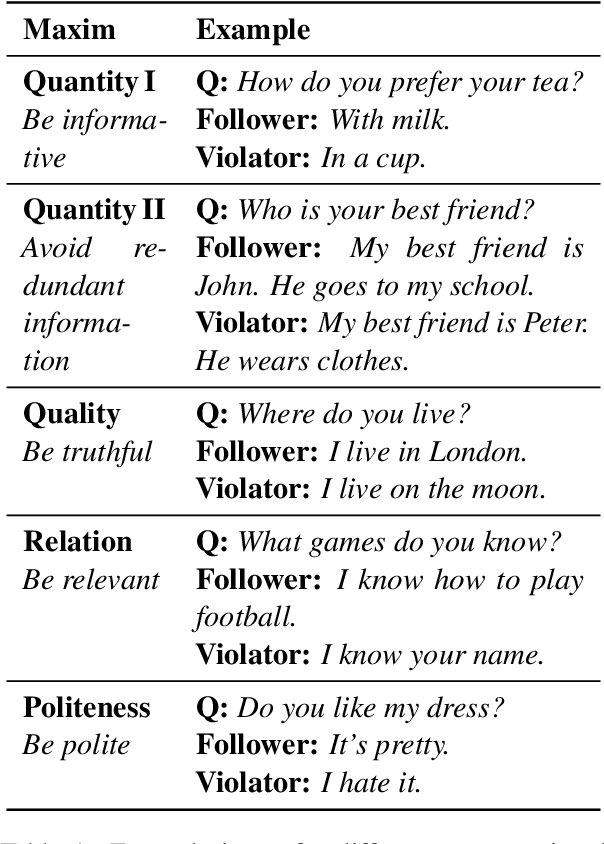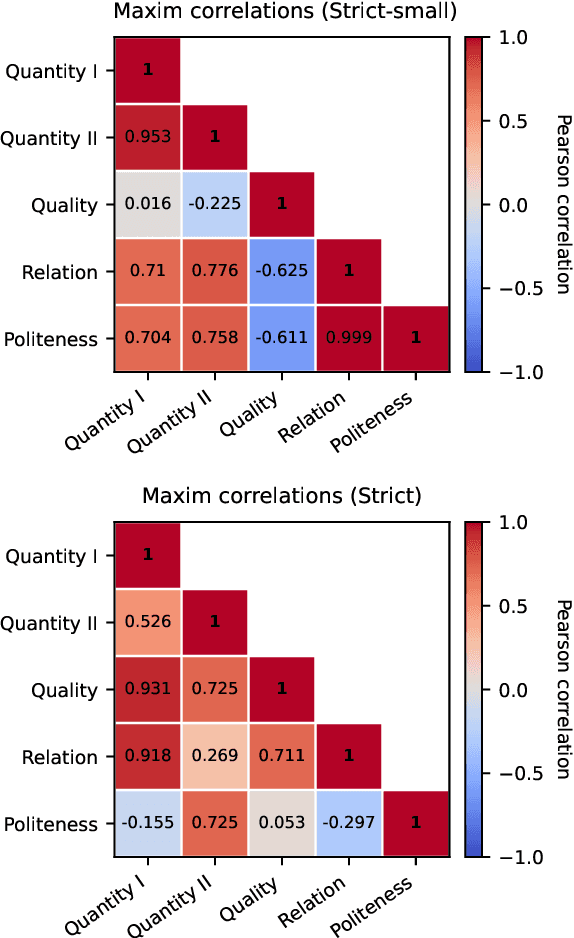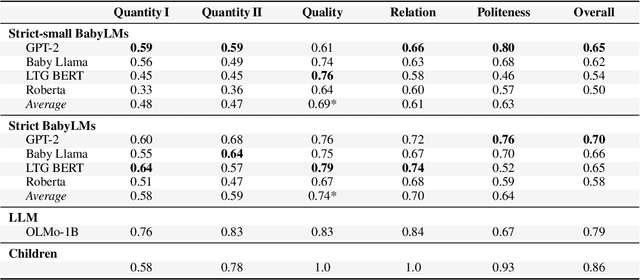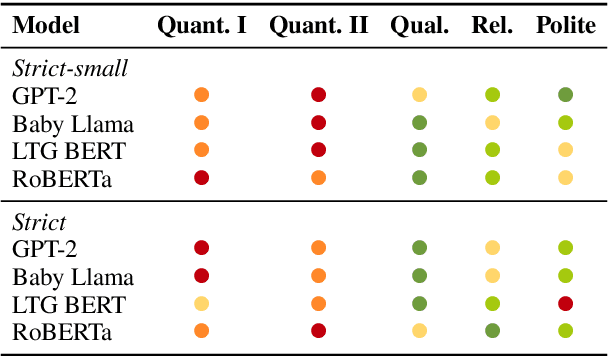Judith Sieker
Are BabyLMs Deaf to Gricean Maxims? A Pragmatic Evaluation of Sample-efficient Language Models
Oct 06, 2025



Abstract:Implicit meanings are integral to human communication, making it essential for language models to be capable of identifying and interpreting them. Grice (1975) proposed a set of conversational maxims that guide cooperative dialogue, noting that speakers may deliberately violate these principles to express meanings beyond literal words, and that listeners, in turn, recognize such violations to draw pragmatic inferences. Building on Surian et al. (1996)'s study of children's sensitivity to violations of Gricean maxims, we introduce a novel benchmark to test whether language models pretrained on less than 10M and less than 100M tokens can distinguish maxim-adhering from maxim-violating utterances. We compare these BabyLMs across five maxims and situate their performance relative to children and a Large Language Model (LLM) pretrained on 3T tokens. We find that overall, models trained on less than 100M tokens outperform those trained on less than 10M, yet fall short of child-level and LLM competence. Our results suggest that modest data increases improve some aspects of pragmatic behavior, leading to finer-grained differentiation between pragmatic dimensions.
Can LLMs Ground when they (Don't) Know: A Study on Direct and Loaded Political Questions
Jun 11, 2025Abstract:Communication among humans relies on conversational grounding, allowing interlocutors to reach mutual understanding even when they do not have perfect knowledge and must resolve discrepancies in each other's beliefs. This paper investigates how large language models (LLMs) manage common ground in cases where they (don't) possess knowledge, focusing on facts in the political domain where the risk of misinformation and grounding failure is high. We examine the ability of LLMs to answer direct knowledge questions and loaded questions that presuppose misinformation. We evaluate whether loaded questions lead LLMs to engage in active grounding and correct false user beliefs, in connection to their level of knowledge and their political bias. Our findings highlight significant challenges in LLMs' ability to engage in grounding and reject false user beliefs, raising concerns about their role in mitigating misinformation in political discourse.
LLMs Struggle to Reject False Presuppositions when Misinformation Stakes are High
May 28, 2025Abstract:This paper examines how LLMs handle false presuppositions and whether certain linguistic factors influence their responses to falsely presupposed content. Presuppositions subtly introduce information as given, making them highly effective at embedding disputable or false information. This raises concerns about whether LLMs, like humans, may fail to detect and correct misleading assumptions introduced as false presuppositions, even when the stakes of misinformation are high. Using a systematic approach based on linguistic presupposition analysis, we investigate the conditions under which LLMs are more or less sensitive to adopt or reject false presuppositions. Focusing on political contexts, we examine how factors like linguistic construction, political party, and scenario probability impact the recognition of false presuppositions. We conduct experiments with a newly created dataset and examine three LLMs: OpenAI's GPT-4-o, Meta's LLama-3-8B, and MistralAI's Mistral-7B-v03. Our results show that the models struggle to recognize false presuppositions, with performance varying by condition. This study highlights that linguistic presupposition analysis is a valuable tool for uncovering the reinforcement of political misinformation in LLM responses.
Towards an Analysis of Discourse and Interactional Pragmatic Reasoning Capabilities of Large Language Models
Aug 06, 2024Abstract:In this work, we want to give an overview on which pragmatic abilities have been tested in LLMs so far and how these tests have been carried out. To do this, we first discuss the scope of the field of pragmatics and suggest a subdivision into discourse pragmatics and interactional pragmatics. We give a non-exhaustive overview of the phenomena of those two subdomains and the methods traditionally used to analyze them. We subsequently consider the resulting heterogeneous set of phenomena and methods as a starting point for our survey of work on discourse pragmatics and interactional pragmatics in the context of LLMs.
The Illusion of Competence: Evaluating the Effect of Explanations on Users' Mental Models of Visual Question Answering Systems
Jun 27, 2024



Abstract:We examine how users perceive the limitations of an AI system when it encounters a task that it cannot perform perfectly and whether providing explanations alongside its answers aids users in constructing an appropriate mental model of the system's capabilities and limitations. We employ a visual question answer and explanation task where we control the AI system's limitations by manipulating the visual inputs: during inference, the system either processes full-color or grayscale images. Our goal is to determine whether participants can perceive the limitations of the system. We hypothesize that explanations will make limited AI capabilities more transparent to users. However, our results show that explanations do not have this effect. Instead of allowing users to more accurately assess the limitations of the AI system, explanations generally increase users' perceptions of the system's competence - regardless of its actual performance.
 Add to Chrome
Add to Chrome Add to Firefox
Add to Firefox Add to Edge
Add to Edge